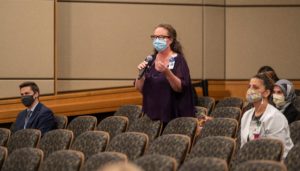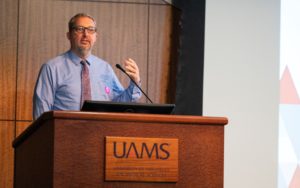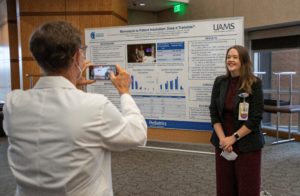UAMS Centers for Simulation Education Holds First Research Day
| The UAMS Centers for Simulation Education held its inaugural Research Day on Nov. 2. The half-day conference, with a theme of “Modern Interprofessional Simulation Education” featured 14 UAMS employees each giving a six-minute presentation followed by a two-minute Q&A session. There was a mid-morning break for the viewing of 24 posters with both in-person and virtual viewing options.
The conference was organized by Karen J. Dickinson, M.D., M.Ed., assistant professor of surgery, director of interprofessional simulation and clinical skills training, and Travis Hill, M.Ed., executive director of Centers for Simulation Education. Debra Nestel, Ph.D., from Monash University, Australia, delivered the keynote address, and Alison Caballero, MPH, from the UAMS Center for Health Literacy delivered an invited lecture.
Moderators for the oral presentation sessions were Amanda Young, M.D., with the College of Medicine’s Emergency Department, Pamela Degravelles, Ph.D., RN, College of Nursing, Faiza Khan, M.D., with the College of Medicine’s Anesthesiology Department and Dickinson.
“I think it is very important for us to break down silos between different specialties and learn from, about and with those in other health care professions,” Dickinson told those assembled at the Fred W. Smith Conference Center in the Jackson T. Stephens Spine & Neurosciences Institute and those joining virtually via Zoom.
Nestel kicked off the morning conference via a videotaped presentation. Nestel is a professor of simulation education in health care at Monash University and professor of surgical education, in the Department of Surgery, University of Melbourne, Australia. She was the founding editor in chief of Advances in Simulation, the journal of the Society for Simulation in Europe. She heads up the master’s program of surgical education in the Department of Surgery, University of Melbourne and Royal Australasian College of Surgeons and the graduate certificate in clinical simulation. She also leads a national program for simulation educators, NHET-Sim in Australia and a virtual network in simulated patient methodology.
Nestel spoke on modern interprofessional simulation education.
“The principles of interprofessional simulation education encompass understanding, valuing and respecting individual discipline roles in health care,” she said. “And interprofessional practice places the interests of patients and populations at the center of health care delivery.”
She added that a key element of interprofessional practice is recognizing and using the skills of other health professionals in health care delivery, working to have interactions that clarify perspectives and enable insights and learning from other health professionals.
“The language of interprofessional practice is complex as is simulation,” Nestel said. She added that research findings of well-designed interprofessional simulations contribute to the overall improvement of quality in health care services.
Standards documents can inform the design of interprofessional simulations, and patients’ perspectives can have a powerful impact on shaping interprofessional simulations, especially ones that are sequential.
“We need less telling and more listening,” she said.
Nestel’s presentation was followed with seven presentations from UAMS employees discussing the use of simulation in their professions. They included Nicole Ward, Ph.D., College of Nursing; Matthew Spond, M.D., Department of Anesthesia in the College of Medicine; Angel Holland, Ed.D., the Department of Physical Therapy in the College of Health Professions; and Joseph Margolick, M.D, the Department of Surgery in the College of Medicine.
Following a break to view posters another seven presenters from UAMS discussed their simulation education research work. These presenters included pharmacy students Hannah Howard, BS and Siddhi Patel, BS; medical student Olivia Speed; Tonya Thompson M.D, Department of Pediatric Emergency Medicine; and Mari Davidson Ph.D., Department of Biochemistry.
Caballero, director of the Center for Health Literacy, was the final presenter with a 30-minute presentation on “Clarity in Health Communication: Roles and Goals for Learning and Practice.”
“We believe this research day is the first of many annual opportunities for the UAMS simulation champions to come together, share their work and ideas and foster interprofessional collaborations for the benefit of our patients,” Dickinson concluded.



